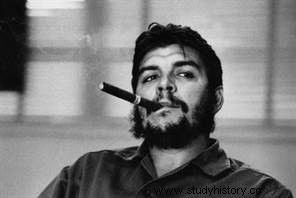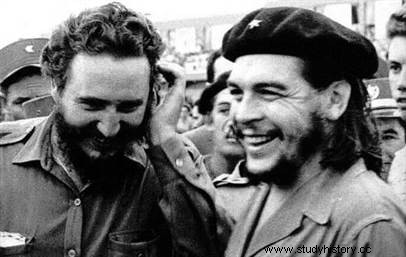 Che Guevara is a revolutionary and guerrilla of Argentine origin, known for having participated in the Cuban Revolution alongside Fidel Castro. Having become the object of a real cult, the incarnation of a Marxist and idealist revolutionary who fought until his last breath, a condottiere of the 20th century who has become an icon, there is no shortage of qualifiers to designate "Le Che" . Behind this legendary figure hides both a man of action, Marxist theoretician and politician who had an eventful career and inspired many revolutionary movements.
Che Guevara is a revolutionary and guerrilla of Argentine origin, known for having participated in the Cuban Revolution alongside Fidel Castro. Having become the object of a real cult, the incarnation of a Marxist and idealist revolutionary who fought until his last breath, a condottiere of the 20th century who has become an icon, there is no shortage of qualifiers to designate "Le Che" . Behind this legendary figure hides both a man of action, Marxist theoretician and politician who had an eventful career and inspired many revolutionary movements.
Che Guevara, a young man initiated into social issues
Coming from a rather wealthy, intellectual and cultured family, Ernesto Rafael Guevara de la Serna was born on June 14, 1928 in Rosario, Argentina. Through his father, who was a civil builder, he was quickly in contact with less well-off social circles, while his highly cultured mother introduced him to French literature. Despite his asthma, he shows his courage and his volunteerism by multiplying the physical activities. An accomplished sportsman, Che also accumulated reading during his youth:from Sophocles to Freud via Voltaire and Baudelaire.
Very early on, he therefore came into contact with social and political issues. On the strength of this solid education and aided by an unlimited curiosity, he began studying medicine in Buenos Aires in 1947. Seeking adventure and taking an interest in pre-Columbian civilizations, Ernesto Guevara embarked on a journey through the Latin America, accompanied by his friend Alberto Granado. This trip played a decisive role in the development of his political future, since he was confronted with striking social realities, such as the condition of minors in Chile.
 In 1953, Ernesto embarked on a second trip which would take him first to Bolivia, in the midst of political ferment the many social reforms underway, then in Guatemala. In this country considered one of the poorest in Latin America, he perfected his political education alongside a Peruvian activist Hilda Gadea, thanks to whom he discovered Mao's thought.
In 1953, Ernesto embarked on a second trip which would take him first to Bolivia, in the midst of political ferment the many social reforms underway, then in Guatemala. In this country considered one of the poorest in Latin America, he perfected his political education alongside a Peruvian activist Hilda Gadea, thanks to whom he discovered Mao's thought.
Alas, a coup d'etat breaks out in Guatemala against President Jacobo Arbenz, supported by the CIA:Ernesto is forced to leave for Mexico, where he will have a decisive meeting . In July 1955, he indeed met Fidel Castro in Mexico City, with whom he shared an anti-imperialist analysis and quickly took a liking to him.
The revolutionary's commitment
Che then decides to join the side of the one who will be called Leader Maximo and joins his July 26 Movement . After receiving military training, he landed in Cuba in 1956 and then received command powers in 1958, actively contributing to Castro's seizure of power in January 1959. In the first act of the Cuban Revolution, Che therefore acquired a reputation of a fine fighter and an exemplary commander.
Once the power of the Cuban dictator Fulgencio Batista was overthrown, Che, if he was not going to take center stage, played an important political role while becoming more radicalized . First a prosecutor of a revolutionary court responsible for eliminating opponents, he held important positions for six years - notably that of Minister of Industry - within the Castro government and participated in the establishment of an economy. socialist.
 As a representative of Cuba, he became known for his qualities as a speaker at international meetings, full period of the Cold War. He then became a true ambassador of the Revolution. In 1965, when he became more and more critical of the USSR, he left his post to resume the armed struggle in the Congo and then in Bolivia with the hope of creating there, on the basis of guerrillas existing, a revolutionary hearth analogous to that of the Sierra Maestra. He leads the revolt of peasants and tin miners against the military government without much success. Faithful to his ideas to the end, he died young and brutally following his capture by the Bolivian army on October 9, 1967.
As a representative of Cuba, he became known for his qualities as a speaker at international meetings, full period of the Cold War. He then became a true ambassador of the Revolution. In 1965, when he became more and more critical of the USSR, he left his post to resume the armed struggle in the Congo and then in Bolivia with the hope of creating there, on the basis of guerrillas existing, a revolutionary hearth analogous to that of the Sierra Maestra. He leads the revolt of peasants and tin miners against the military government without much success. Faithful to his ideas to the end, he died young and brutally following his capture by the Bolivian army on October 9, 1967.
Che Guevara:a political model
Through his major role in the success of the Cuban Revolution, a veritable state cult to Guevara has settled over time on the island of Cuba. Upon his death, the flags are lowered in Cuba for 30 days and the day of October 8 is commemorated as that of the "heroic guerrilla". Several ceremonies are organized on the island then led by Fidel Castro, bringing together large emotional crowds. While he was sometimes disturbing in Cuba, Che Guevara rose to the rank of myth through the speeches of his fellow fighter Fidel Castro, who particularly insisted on his exemplarity.
Later, in 1987, when Cuba was facing economic difficulties, Castro used the integrity symbolized by Che to remobilize Cubans. This cult to Guevara grew with the repatriation of his remains in July 1997 to Cuba. In October, for the 30th anniversary of his death, a state funeral is organized and his remains are transferred to the Che Guevara Memorial in Santa Clara:Che has his place of worship.
Che inspired far-left movements in the 1960s through his actions and writings. Through his criticism of the USSR, he embodies an alternative to the Soviet model. First for the JCR (Revolutionary Communist Youth), he is with Trotsky an important reference, but also within Maoist currents. This is why we see him emerge in the streets and behind the barricades of May 68, through numerous portraits bearing his effigy. After a slump in the 80s, it is now taken over by the French far left, since Olivier Besancenot recently devoted a book to Guevara which he considers to be one of his references.
 Although he was an important figure for European youth in the 1960s, Guevara inspired more radical movements:the guerrillas. While the guerrilla movements of the 1960s-70s which had Guevara as a reference wanted to copy the Cuban model, he became an important inspiration for all guerrillas:such as the Brazilian MST which claims Guevara but is not guevarist. In Colombia, a guerrilla group, the ELN openly claims Guevarism. Finally in Mexico, the EZLN of Subcomandante Marcos, counts Guevarism as one of its references.
Although he was an important figure for European youth in the 1960s, Guevara inspired more radical movements:the guerrillas. While the guerrilla movements of the 1960s-70s which had Guevara as a reference wanted to copy the Cuban model, he became an important inspiration for all guerrillas:such as the Brazilian MST which claims Guevara but is not guevarist. In Colombia, a guerrilla group, the ELN openly claims Guevarism. Finally in Mexico, the EZLN of Subcomandante Marcos, counts Guevarism as one of its references.
While there are few openly Guevarist movements, Che remains a symbol of the struggle against injustice, against imperialism, and the possibility of transforming a system through revolutionary initiative.
Beyond political and ideological recovery, Che is today a figure deeply rooted in popular consciousness. This anchoring is made possible thanks to several factors:popular masses, recovery for economic and advertising purposes.
It is indeed Latin America that is the main source of maintenance for the myth of Che. He is in certain regions of Latin America perceived as a martyr, by the brutality of his death. Thus, in Bolivia, in the area where Che was captured, some peasants, who at the time did not understand or accept his call to struggle, made him a sort of saint.
Since his death in 1967, the story of Che has been passed down orally, making him a popular legend, where he is renamed San Ernesto de la Higuera. We should also add that since 1995 several tourist projects following in the footsteps of Che have been under discussion between several Latin American countries, including Argentina, Bolivia and Cuba.
Maintaining the myth of Che Guevara
 What about the artistic phenomenon around Che? It essentially comes down to a famous photograph:the photo of Korda (photographer assistant of the Revolucion newspaper), taken on March 5, 1960, expressing all his virtues:honesty, bravery, selflessness, loyalty, pride, authority, commitment with this star on his beret, negligence with his atypical hair and imposing beard. All this contributes to a mythical denomination:"Guerrillero Heroico".
What about the artistic phenomenon around Che? It essentially comes down to a famous photograph:the photo of Korda (photographer assistant of the Revolucion newspaper), taken on March 5, 1960, expressing all his virtues:honesty, bravery, selflessness, loyalty, pride, authority, commitment with this star on his beret, negligence with his atypical hair and imposing beard. All this contributes to a mythical denomination:"Guerrillero Heroico".
It appears on the cover of a book only after Che's death. It is then conveyed by art, through Jim Fitzpatrick, an Irish artist who stylizes the portrait, exposing a very contrasting face of Che on a plain colored background. In the 1990s, this image was taken over by advertising, which understood the value of the protest character of this image.
Concerning the 7th art, several adaptations have appeared. First of all, “Carnets de Voyages”, by Walter Salles, released in 2004, which retraces Che's journey with Alberto Grenado and insists on his fundamental role in the construction of Che's thought. More recently, in 2009, “Che:the Argentinian” then the second part “Guerilla” by Steven Soderbergh, which retraces Che's battles. These two films do not approach the life of Guevara critically and tend instead to spread a positive image of the guerrilla.
Finally, the Guevarian myth takes shape with a song by Carlos Puebla (1917-1989), nicknamed the "Singer of the Cuban Revolution", which is a true eulogy of Che. This version, with its typically Cuban sounds, is a real tribute to Che and quickly acquired great popularity, testifying to the mobilizing role played by the figure of Che. This song was also covered in 1998 by Nathalie Cardone, and as a sign of Che's great popularity, was also a great commercial success.
Through the breadth of his action and the influence of his thought, Che Guevara has become a major figure in Latin America and in the history of the 20th century. It is also the unfinished taste of his work that contributes to many political movements to claim Che, and the charisma he exudes that have made one of him a symbol of resistance many times recovered.
Bibliography
- ABRASSART Loïc, Che Guevara, Itineraries of a revolutionary. Edition Milan, 2007.
- KALFON Pierre, Che Ernesto Guevara – A legend of the century. Threshold, 1997.
- Che Guevara:The Time of Revelations , by Jean Cormier. Editions du Rocher, 2017.
